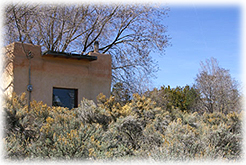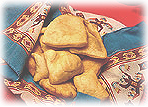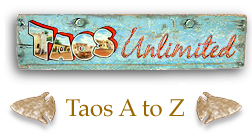|
|||
 Sagebrush SagebrushA coarse, aromatic, silvery-grey shrub with yellow flowers (of the daisy family), sagebrush grows in arid climates, and is common throughout New Mexico. Sagebrush has a strong pungent fragrance, especially when wet, which is not unlike common sage. It is, however, unrelated to common sage and has a bitter taste. It is thought that this odor serves to discourage browsing. (~Aimee) Salsa The word salsa is derived from the Latin word salsa (meaning salty) and sal (meaning salt). Salsa may refer to any type of sauce. In English it usually refers to the spicy, often tomato based hot sauces typical of Mexican cuisine; particularly those used as dips for corn tortilla chips. Most jarred, canned, and bottled salsa sauces sold in American grocery stores are forms of “salsa cruda/pico de gallo,” but to increase their shelf life, they have been cooked with vinegar added. These are not as authentic as freshly made salsas and typically have a semi-liquid texture more akin to that of canned tomatoes or chunky pasta sauces. There are fresh, all-natural jarred salsa products produced regionally that do not use artificial ingredients or chemicals to enhance shelf life. Fresh, refrigerated salsas, usually packaged in plastic containers, are also readily available, due to the enormous popularity of this appetizer/snack. (~Jean)  Sarsaparilla SarsaparillaDefinition: “a preparation of the dried rhizomes of various plants, especially smilax, used to flavor some drinks and medicines, and formerly as a tonic; a sweet drink flavored with this.” The primary uses of sarsaparilla are the flavoring of beverages and in folk medicine. As a medicinal product, sarsaparilla is supposedly a “blood purifier,” an aid to detoxing, and a general “pep agent” that is traditionally used in cordials and tonics to invigorate and cleanse the body. The sarsaparilla plant is mostly a vine, found primarily in Mexico, Central America and South America, although is has also been found up and down the East Coast of the United States. The most valued portion of the sarsaparilla is the root, which has been used for medicinal purposes for centuries, much like ginseng or licorice root. Natural sarsaparilla root is very bitter, so it was a common practice for pharmacists to distill the useful chemicals and mix them with sugar water. Thus, a popular beverage called sarsaparilla was born. It was enjoyed in its day, as Coca-Cola has been throughout the 20th century. The drink was actually called either sarsaparilla or “sasparilla,” and tasted much like today’s root beer. Other formulas substituted sarsaparilla root with a combination of birch oil and sassafras, a tree found in the western United States. Some believe the informal name of the drink, “sasparilla,” indicates the use of sassafras extract. Others say the name is simply a corruption of the original word, sarsaparilla. In the Old West, cowboys would drink sarsaparilla before making the rounds of the brothels. They thought it would ward off venereal disease. And Native Americans on the East Coast believed sarsaparilla was the supreme spring and blood tonic. A carbonated beverage called sarsaparilla is still manufactured today, but its taste is largely the result of artificial flavorings. Yet, bottled sarsaparilla can still be found in some old-time country stores and upscale grocery stores. (~Jean) Serape A long blanket-like shawl, often brightly colored and fringed at the ends, worn especially by Mexican and Southwest Indian Men. (~Aimee)  Sopaipilla (or Sopapilla) Sopaipilla (or Sopapilla)A crisp, puffy, deep-fried pastry resembling an air-filled pillow. The sopaipilla is thought to have originated in Albuquerque, New Mexico, more than 200 years ago. It's a favorite Southwestern meal accompaniment, served with a honey bear for drizzling. Sopaipillas are also served as desserts, or sometimes filled with savory ingredients like refried beans. (~Aimee) Pictured top to bottom: 1} Sagebrush surrounds a house outside of Taos, New Mexico; 2} Vintage sarsaparilla bottle; 3} Delicious sopaipillas |
|||
Home | Food | Lodging | Merchants | Services | Real Estate | Art & Galleries | Entertainment | Recreation Ski Areas | Mind-Body-Spirit | Taos Information | Local Color | Taos Pueblo | High Road to Taos | Taos Plaza | Ranchos de Taos Scenic Beauty | Day Trips | Chili | Special Events | Taos History | Multicultures | Museums | The Enchanted Circle The Wild West | Taos Art Colony | Plants & Wildlife | Counterculture | Turquoise | Architecture | Features | About Us | Get Listed! Taos Unlimited Trading Post | Photo of the Week | Link of the Month | Taos Webcams | Taos Weather | Testimonials | Guestbook Taos A to Z | Movie Locations | Sitemap | Taos Unlimited Blog | Aimee & Jean's Story Blog | Contact Us | Santa Fe Unlimited |
|||

